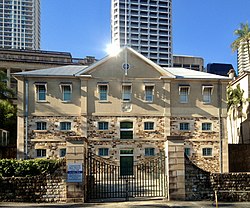| Commissariat Store, Brisbane | |
|---|---|
 Queen's Wharf Road facade of the Commissariat Store | |
| Location | 115–127 William Street, Brisbane City, City of Brisbane, Queensland, Australia |
| Coordinates | 27°28′24″S 153°01′27″E / 27.4732°S 153.0242°E |
| Design period | 1824–1841 (convict settlement) |
| Built | July 1828 – 1829, 1913 |
| Built for | Moreton Bay penal settlement |
| Restored | 1969, 1978–1981, 1998–2001 |
| Current use | Royal Historical Society of Queensland |
| Architect | William John Dumaresq |
| Architectural style(s) | Georgian |
| Owner | Queensland Government |
| Website | www |
| Official name | Commissariat Store (former), Government Stores (1898–1923), State Stores Building (1923–1960), Commissariat Stores (former), Colonial Store (1860–1898) |
| Type | state heritage (built) |
| Designated | 21 October 1992 |
| Reference no. | 600176 |
| Significant period | 1828–29, 1890, 1912–13 (fabric) 1829–1960 (historical) |
| Significant components | fence/wall – perimeter, store/s / storeroom / storehouse, wall/s – retaining, yard |
| Builders | Convict labour |
The Commissariat Store is a heritage-listed storehouse at 115–127 William Street, Brisbane City, City of Brisbane, Queensland, Australia. It is bordered by William Street, Queen's Wharf Road and the Brisbane River, and is the birthplace of Queensland. It was designed by William John Dumaresq and built from 1828 to 1913 by convict labour under the direction of Captain Logan as a permanent Commissariat Store for the Moreton Bay penal settlement. It is also known as Government Stores, State Stores Building, and Colonial Store. It was added to the Queensland Heritage Register on 21 October 1992.[1]
The building is one of only two surviving buildings from the convict period in Queensland,[2] and is one of only four surviving commissariat buildings in Australia. It is the second oldest building in Queensland, dated to 1829, the oldest building being the Windmill at Wickham Park, dated to 1828. However, the Commissariat Store is the oldest currently occupied building in Queensland, as it is currently occupied by the RHSQ, housing a museum, the Welsby Library, and function spaces.
- ^ "Commissariat Store (former) (entry 600176)". Queensland Heritage Register. Queensland Heritage Council. Retrieved 1 August 2014.
- ^ Statham, Pamela (1990). The Origins of Australia's Capital Cities. Cambridge University Press. p. 257. ISBN 0521408326. Retrieved 21 February 2013.
